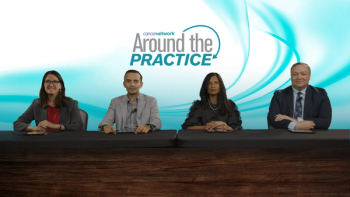
Clinical Scenario: A 52-Year-Old Woman With Chronic GVHD
Nelson Chao, MD, MBA, presents the clinical scenario of a 52-year-old woman with chronic graft-versus-host disease for discussion.
Episodes in this series

Nelson Chao, MD, MBA: So, the second patient is a 52-year-old woman with B-ALL. She's treated in a clinical trial. She achieved an MRD-negative complete remission and went on to receive fractional total body radiation with a matched sibling donor, and received tacrolimus for GvHD prophylaxis. She developed acute GvHD: skin stage 1, upper GI stage 1, lower GI stage 2. She was started on corticosteroids at one milligram per kilo per day, and that responded; she improved. So, she was discharged, was doing well, went home, came back, or represented on day 170 with diarrhea five times a day, anorexia, elevated liver function test, and also reported tightness around her mouth and in her ankles. She was started on steroids at 1.5 milligrams per kilo per day for two weeks and returned to the clinic with an increase in diarrhea, now with nausea and vomiting. The steroids were increased to two milligrams per kilo per day, and she was admitted due to dehydration and weakness. So, Catherine, what do you think about this situation?
Catherine Lee, MD, MS: I feel horrible for the patient. First of all, this is a really unfortunate situation, and it is an example of when patients are released back to their local home and may not be under close supervision, and then they return as a train wreck with these severe symptoms. So, I guess, just listening to the case study, it brings up a couple of questions. When the patient developed acute graft-versus-host disease, it was treated successfully with corticosteroids. And I guess the first question that comes to my mind is, what was going on with the tacrolimus and sirolimus at this time? Did the patient just stop taking her medications? Had she been weaned off? But regardless of that, the fact that she presents around month six with these GI symptoms and elevated liver function tests, and as well signs of chronic GvHD as she's reporting tightness around the mouth, I mean, this needs to be treated urgently. At this point, I would have admitted the patient into the hospital and started high-dose steroids, as was done here. I would have started at one milligram per kilogram per day, thinking that this might be acute and chronic graft-versus-host disease and knowing that some of the other treatment options take a little bit longer to take effect. So, I would have started corticosteroid equivalent at two mg per kg per day and watched very carefully. And if she did not respond definitely by five days, I would have added a second-line agent and started tapering off the corticosteroids. So that would have been my practice. I don't find a reason here to increase the steroids up to two after someone doesn't respond to 1.5. And I felt, in this situation, the patient was left too long on this 1.5 milligram per kg per day dose.
Nelson Chao, MD, MBA: Totally agree. Hana, any other thoughts on this patient?
Hana Safah, MD: Catherine is thinking the way I'm thinking; that this could be an overlap because you're having some signs that this is more of the acute phase and plus presenting with the chronic phase. So, I agree with her completely that I would have been giving the higher dose earlier compared to what was done here. After flare, if the patient doesn't respond, I don't think going, even if she was on the 1.5, at five days, I truly evaluate these patients very early on. If there is no evidence of response by day five or if they're progressing by day five and there is no evidence of response by day seven, I usually elect to go to a second line rather than increasing the dose of steroids as such.
Erin Kopp, NP: This is an excellent representation of the type of patients that we receive and the questions that often come with them. If they're not continuing to receive care in the institution where they were transplanted, and there are changes to their immunosuppressive regimens or changes to steroids or presentation of symptoms, we don't always get the full report of what happened. And so, they do show up on my doorstep looking like this. And the questions still remain with the patient who's very acutely ill. The other piece about being hospitalized earlier and the steroid dose is, I think, very important because sometimes these patients see an outside provider who's not yet notifying the transplant center and the dose adjustments, or somebody who has seen transplants but not seen this overlap syndrome and noting the acuity 100%. I think that one thing we need to focus on is how often we're monitoring our patients at critical milestones. When you initiate steroids, the concept that the patient needs to be closely followed—three, five, seven days, I heard all of those ranges—but much closer than two weeks because we can identify sometimes as early as three days whether a patient is responding or not to the corticosteroid dose that we have initiated. And then we have the opportunity to prevent the worsening of what's going on. And I'm hoping that this illustrates the challenges of the many physicians and other healthcare professionals that are working with this one patient. But when care is not centralized, there is the risk for this. And that's one piece of education that I think we can do. And that's on the onus of everyone who interacts with the patients: to say, when there's a new symptom or there's a change in something that we do, sometimes the patient has to advocate for themselves and say, "How can I see you in another week?" or calling to their transplant physician or the long-term care clinic if they have that, so that we're aware of it sooner rather than later. Because all of the things make sense, but we have to have access to the patient to do that.
Nelson Chao, MD, MBA: Yes, the key message really is that patients like this are sick, and that two weeks of steroids in these patients is really inappropriate when they're obviously not responding. So, I suppose, given the discussion we had earlier, RUX would be the drug we would all pick.
Hana Safah, MD: I agree with you. Ruxolitinib is indicated. It's approved for second-line therapy in patients who are refractory to steroids. So, yes, I think this patient would be very appropriate for such a treatment.
Nelson Chao, MD, MBA: Do we have a sense, does it matter which organ is involved in terms of this outcome?
Hana Safah, MD: I mean, we know that with ruxolitinib, when you look at the trial, the benefit was seen across all organs. I think, as Catherine mentioned earlier, it's the cytopenias. I'll be a little bit hesitant if usually patients with chronic GvHD are not as cytopenic as patients with acute GvHD. So, we have the luxury of having a good count in these patients when they present, and they need a second line. But some of them do present with cytopenia, especially those who have a platelet count of less than 100. We know they're not going to do as well, and they are in need of urgent therapy. So, it really doesn't matter which organ is involved, but it's the count that I would be paying attention to more than anything else.
Erin Kopp, NP: There's also that question of platelet count; there's certainly a concern for those patients with lower platelet counts, especially when we're making that switch from corticosteroids to ruxolitinib. And I think another thing, if we're going to be watching this patient's lab and monitoring the patient very carefully, we're also going to be looking at the symptom burden that the patient is experiencing, as well as nutritional status, hydration status, and really trying to get the entire picture, so we can better understand what the patient is going through and be able to treat them in the most appropriate manner possible.
Nelson Chao, MD, MBA: Well, thank you all for this discussion. I think it's been extremely educational, and I think the cases were illustrative. Thank you.
Newsletter
Stay up to date on recent advances in the multidisciplinary approach to cancer.


















































































